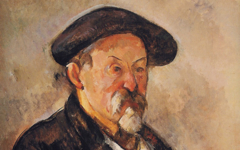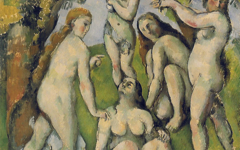Cézanne’s Portrait of Geffroy (1895) and later portraits
Cézanne's Portrait of Gustave Geffroy is said to hold the same iconic place in Cézanne's oeuvre that the Portrait of Zola does in Manet's.1 It is notable then that Theodore Reff sees "a dark, flickering spirituality" in this and other later portraits. He also notes that if Cézanne can "embody [in these and other portraits]..the dignity and restraint that are so characteristic of his own behavior, it is because [these faces] represent for him.... an unassuming simplicity and natural nobility which he admires and with which he can identify the finest qualities in himself."2
Click next thumbnail to continue

Left: Detail of Cézanne's Portrait of Gustave Geffroy
Right: Contemporaneous photograph of Cézanne
Click image to enlarge.
Reff's ability to perceive Cézanne's own persona in these late figures is, of course, correct. He could have added that Geffroy's features which he described as "a pleasant mask" are, in fact, a younger variation of Cézanne's own3. A contemporaneous photograph reveals the same pattern to the eyebrows, the same shape face and nose above the same droop to the moustache. Even their black coats resemble each other with Geffroy's wide-cut lapels somewhat lower down the chest.
Click next thumbnail to continue
Cézanne's Portrait of Joachim Gasquet from a year later has one eye open, the other virtually blacked out, a motif we have shown has a long history in the history of art as a symbol of an artist's dual perception: inwards and outwards. Gasquet, it would then appear, also represents Cézanne. That is probably why Gasquet's teacher when he saw the portrait years later remarked: "I thought I had plumbed the soul of my pupil, and yet this portrait shows me a Gasquet I did not know. I see now that the real Gasquet was not the ingenuous creature I took him for."4 Cézanne, of course, never intended an accurate representation of Gasquet's character but of his own creative spirit.
Click next thumbnail to continue
The third portrait, three years later, of Cézanne's dealer has mask-like face too, so overpainted that it appears cut-out from his hair. Reff remarked that the face "says little about Vollard's colorful and crafty personality."5
Click next thumbnail to continue

Left: Detail of Cézanne's Portrait of Amboise Vollard
Right: Cézanne, Self-Portrait with a Turquoise-Green Background (c.1885)
Click image to enlarge.
It does, however, resemble a self-portrait from fifteen years earlier, showing the artist much younger than he actually was. Reff's insights then into these late portraits are fully supported by our own methods. "Cézanne", he writes, "makes the very process by which he transforms nature into art the very substance of his art."5 In other words, he studied the workings of his own mind and portrayed those mental processes on canvas and paper. He was not alone, as we try to show; he learnt his methods from his predecessors.
More Works by Cezanne
Notes:
1. Reff, "Painting and Theory in the Final Decade" in Cézanne: The Late Years (New York: Museum of Modern Art) 1977, p.14
2. ibid., p.22
4. ibid, p.14
5. ibid.,p.21
Original Publication Date on EPPH: 11 Aug 2011. | Updated: 0. © Simon Abrahams. Articles on this site are the copyright of Simon Abrahams. To use copyrighted material in print or other media for purposes beyond 'fair use', you must obtain permission from the copyright owner. Websites may link to this page without permission (please do) but may not reproduce the material on their own site without crediting Simon Abrahams and EPPH.






